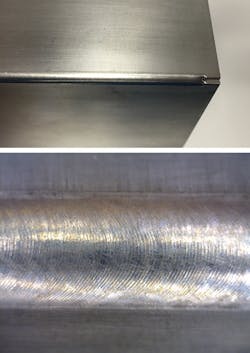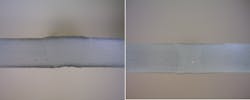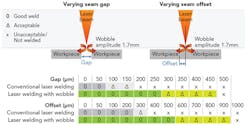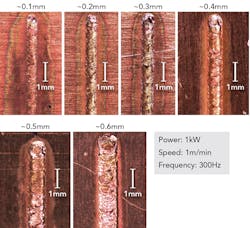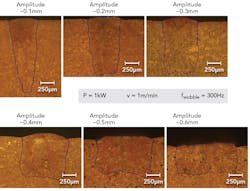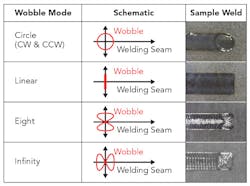
BRYCE SAMSON, TONY HOULT, and MUSTAFA COSKUN
The move towards adopting lighter and stronger materials in everyday products, from automobiles to consumer electronics, has led to a number of significant challenges in welding these structures, especially in high-volume production environments. Examples in the transportation industry include electric vehicle infrastructure, where battery manufacturing often requires joining of dissimilar highly reflective materials such as aluminum and copper.
Further adoption of high-strength steels, together with aluminum and magnesium composites for weight reduction in automobiles, is another related example. In consumer electronics, the requirements for lightweight structures with highly tailored thermal and electrical properties are constantly driving the need for more complex designs, often using thin foils and requiring joining of dissimilar metals, again with aluminum and copper being the heavily featured materials. The medical device industry is also driving the need for joining small metal parts, often with dissimilar materials.
Growth of laser welding has been ongoing for over a decade, with the automotive industry—an early adopter of the technology—being the first to see the benefits of an automated joining process combined with the intrinsic advantages of fiber laser technology. However, the challenges of laser welding many of the materials described previously have remained significant and could explain the slow rate of the adoption of laser welding in some applications.
Recently, the introduction of a new, cost-effective, easy-to-integrate technology, based on a beam wobbling technique, is helping to overcome some of these difficulties in welding materials such as copper and aluminum with high-brightness fiber lasers at 1μm. This technique is helping to overcome porosity and hot cracking issues with laser welding of some materials, while helping to make part fit-up 3X more forgiving in some of the examples discussed in this article. By enabling independent control of penetration depth, spot velocity, weld speed, and seam width, the technique has applications in welding small, temperature-sensitive assemblies (for medical parts)—poorly fitted parts that can be difficult to laser-weld and cosmetically attractive to weld without the need for post-processing.
Wobble head technology
FIGURE 1 demonstrates the concept of the 2D dynamic beam motion or wobble head technology, where the four basic programmable shapes available from an industry-standard welding head, such as the D30 from IPG Photonics, are shown. Independent control of the amplitude and frequency of the oscillation is achieved through the galvo-mirror controller, allowing more flexibility in stabilizing the keyhole melt during the welding process, with typical frequencies up to 300Hz used in most applications. Power handling of commercial wobble welding heads is now available up 12kW.
Stability of the keyhole melt is a critical factor when laser welding difficult high-reflectivity materials such as copper and aluminum. This is partly because of the tendency to spatter and, in the case of some aluminum alloys, exhibit a high level of porosity because of the viscosity and surface tension of the melt, making these materials a challenge to weld using more traditional laser welding techniques. Recent studies [1-4] have shown the reduction or elimination of these problems with the beam wobble technique, including a recent systematic study both with and without filler wire on automotive aluminum alloys [2].
Overall, the wobble technique allows for better temperature management of the part since the beam passes near any given point of the weld multiple times. The ramp in temperature and cooling rates are slower than in traditional laser welding, which helps in eliminating defects and managing spatter. In addition, this welding technique is compatible with typical welding accessories such as assist gas ports and coaxial nozzles, which enable plume suppression and can help control spatter—techniques that are not readily compatible with the scan heads used in remote welding.
In addition to stabilizing the keyhole melt and reducing porosity in the subsequent weld, the beam wobble technique has proved valuable for alleviating the part fit requirements for laser welding, as summarized in the TABLE. Using one of the programmable shapes (infinity in this case) and optimizing the amplitude and frequency of the oscillation, an increase in the acceptable seam gap of 3X that achieved in conventional laser welding is seen.
A similar improvement in the process window is also observed for the seam offset when utilizing the beam wobble technique, allowing a 2–3X increase in offset when compared with conventional laser welding.
Example implementations
An example of the weld quality and consistency achieved with the wobble head is shown in FIGURE 2 for welding of 6061-T6 aluminum, a quality of finish that would not be possible with conventional laser welding. It can eliminate post-processing of the weld to achieve a cosmetic finish of the final part.Upon further inspection, the reduction of the porosity associated with the beam wobbling technique is evident (FIGURE 3), where the cross-section is compared with conventional laser welding on 6061 aluminum, showing the absence of pores when using the wobble-head welding process. Similar improvements in porosity have been reported [2, 4] using the wobbling technique and attributed to the mixing of the molten bath during the keyhole rotation, which occurs with the beam wobble process.
Wobble-head welding of copper
Some of the challenges associated with welding copper using lasers operating at 1μm are well known and covered previously [1]. In that study, we utilized a single-mode fiber laser and a small spot size to increase the fluence at the workpiece and help stabilize the keyhole melt. This has been studied in some detail in micro-welding of thin foils [5], but is a feature applicable to wobble-head welding, where we are utilizing a small spot and more-efficient keyhole in the process. In our experience, the linear speeds and total heat input (power from the laser) is often comparable to the traditional laser welding. Typically, at lower speeds, an unstable coupling of the laser and clear spatter ejection from the keyhole melt a result of the high reflectivity of copper and low viscosity and surface tension of the material. The trend at higher speeds is a stable weld enabled by the high fluence and small spot size from a single-mode fiber laser. However, this comes at an expense of a reduced penetration depth of the final weld.The wobble-head technology is fully compatible with multimode fiber lasers, and in our tests [1] copper welds using a high-power (5kW) fiber laser operating together with the wobble head were demonstrated . In the case of the higher power levels, greater penetration depth is achieved (up to 4mm, in this case) and, as in the previous study, the additional process flexibility associated with the wobble-head technology is used to control the keyhole and stabilize the melt during the process.
Aluminum-to-copper overlap welding for the battery industry is the final application reviewed in this article. In this case, the penetration depth is a critical parameter to minimize the intermetallic formation (ideally less than 10μm), which can be controlled by the speed of the process in traditional laser welding. However, in the case of utilizing the wobble-head technique, we have the additional control weld width and penetration through the amplitude and frequency functions on the wobble head.
In our study, , we see the effect of an increase in wobble amplitude (from 0.2 to 1.2mm). This is achieved by increasing the weld width, minimizing the penetration depth, and subsequently improving the mechanical properties of the weld between the aluminum and copper parts.
Conclusion
The difficulties associated with laser welding of materials such as aluminum and copper using 1μm lasers can largely be overcome by using high-brightness fiber lasers together with the latest 2D wobble-head technology for additional beam control of the keyhole melt during the welding process. In turn, this is shown to help eliminate porosity and sputtering associated with laser welding of these materials using traditional techniques. The additional degrees of freedom achieved through independent amplitude and frequency of the wobble-head oscillation, when combined with the high brightness and power available from the fiber laser, offer the level of control needed to achieve good-quality laser welding in difficult materials.
Examples presented here are laser welding of difficult materials such as aluminum and copper as well as welding of dissimilar materials, including control of the intermetallic mixing region with the wobble-head technology. In addition, the technology offers significant advantages in part fit through relaxed tolerance on seam gap and offset in studies comparing the wobble head with traditional laser welding processes. Suitability of the technique with both single-mode and multimode high-power fiber lasers is also shown in the study. Finally, the technology is compatible with standard welding accessories such as assist gas delivery ports and coaxial nozzles.
REFERENCES
[1] T. Hoult et al., "Welding solutions for challenging metals with ytterbium fiber lasers," ICALEO 2016presentation, San Diego, CA (Oct. 2016).
[2] G. Barbieri et al., Mater. Sci. Forum, 879, 1057–1062 (2017).
[3] O. Berend et al., "High frequency beam oscillation to increase the process stability during laser welding with high melt pool dynamics," Proc. ICALEO, 1041, 1032 (2005).
[4] G. Barbieri et al., Procedia Eng., 109, 427–434 (2015).
[5] I. Miyamoto et al., "Precision microwelding of thin metal foil with single-mode fiber laser," Proc. SPIE, 5063, 297–302 (2003).
BRYCE SAMSON ([email protected]),TONY HOULT, and MUSTAFA COSKUN are all with IPG Photonics, Oxford, MA; www.ipgphotonics.com.
